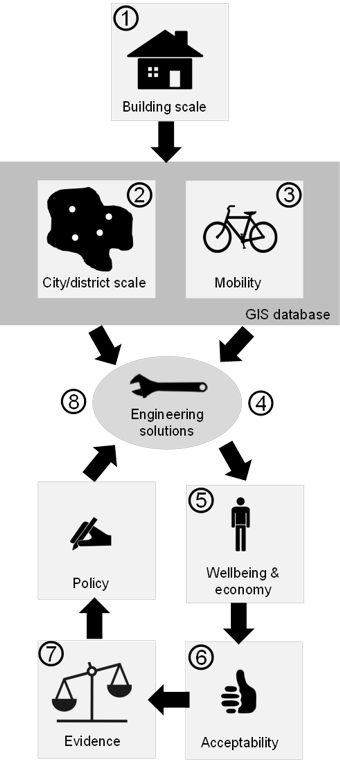How do we address energy consumption to meet low carbon targets? How do we address infrastructure ‘lock in’ to improve the carbon performance of the urban environment? How do we engender and embed low carbon pathways and engineering solutions for demand reduction and power generation in cities?
Introduction

Liveable cities information flow chart highlighting the holistic approach addressed in the research programme.
Launched in 2012, Liveable Cities is a five year £6.2m research programme jointly between the Universities of Southampton, Birmingham (lead), UCL and Lancaster. It has the ambitious aim of transforming “the engineering of cities to deliver global and societal wellbeing within the context of low carbon living and resource security through developing realistic and radical engineering that demonstrates the concept of an alternative future.” In concrete terms, this means assessing where cities are today, where we need to get to by 2050 in order to meet carbon reduction targets, how this might change under different scenarios and what might happen to people’s wellbeing in the process.
Liveable Cities is a programme grant, which means that it is designed to support a range of research activities arranged around a central theme, in this case low carbon cities. Unlike smaller research grants which are focussed on specific objectives, a programme grant is more flexible and the individual research components will evolve over the five-year period.
The figure on the right shows how the different components of the project to be investigated by SERG in collaboration with the other partners fit into the project as a whole. A baseline study will characterize the energy performance of the target cities over a range of scales (1), integrated within a GIS platform, looking holistically at building and transport emissions (2 and 3). The baseline analysis will inform targeted case studies (4) engineers working in tandem with social scientists will assess how people behave in response to technological solutions and whether it has a positive or negative impact on their wellbeing (5) the technological solutions will be tested for acceptability (6) with interested parties, including, for example, local government. This will lead to a body of evidence (7) which will, in turn, inform revised technological solutions and finally policy guidance for transforming cities by 2050.
The research will be carried out by a team from Engineering and the Environment’s Sustainable Energy Research Group, working together with researchers from Social Sciences.
Project updates
Liveable Cities – Proving trials
9 Case Studies showcase the breadth and applicability of the Liveable Cities research to practice and to everyday life.
Read them online and download a PDF copy.
Liveable Cities – Little Book series
Following the roadshows and a successful closing event in the House of Lords, the Liveable Cities – Little Book series are now available online to download as PDF.
The Little Books aim to be easy to read and accessible in order to inform the public about some of the key research outputs and the main findings of the Liveable Cities research programme.
Rezoning of Southampton Itchen Riverside
Following the Liveable Cities meetings in Southampton and in Lancaster, the rezoning of the city theme is to initially focus on the area around the West bank of the River Itchen. This is a highly deprived, industrial area of the city which contains a number of Wharves and St. Mary’s Stadium (home ground of Southampton Football Club).
An overview of the key findings and conclusions is available in the Little Book of Rezoning and the Rezoning Case Study.
Below is a video produced by Southampton City Council with bird’s eye view of the entire rezoning area.
Itchen Riverside VIP Project from Invest Soton on Vimeo.
Results and publications
- Wu Y., Blunden L.S. and Bahaj A.S. (2017) City-wide building energy efficiency assessment using EPC data. In, SET2017: 16th International Conference on Sustainable Energy Technologies, Bologna, 17 – 20 July 2017. view paper
- Harper M., Anderson B.,James P.A.B. and Bahaj A.S.(2017) Identifying suitable locations for onshore wind turbines using a GIS-MCDA approach. In, SET2017: 16th International Conference on Sustainable Energy Technologies, Bologna, 17 – 20 July 2017. view paper
- Paine S., James P.A.B. and Bahaj A.S.(2017) Evaluating CHP management and outputs using simple operational data. In, SET2017: 16th International Conference on Sustainable Energy Technologies, Bologna, 17 – 20 July 2017. view paper
- Alvares-Sanches T., Osborne P.E., White P., James P.A.J. and Bahaj A.S.(2017) Temporal and spatial variation in soundscape frequency components across an urban area. In, SET2017: 16th International Conference on Sustainable Energy Technologies, Bologna, 17 – 20 July 2017. view paper
- Turner P., Bahaj A.S. and Teli D.(2017) Aspirations of retailers and visitors towards the regeneration of declining streets in cities. In, SET2017: 16th International Conference on Sustainable Energy Technologies, Bologna, 17 – 20 July 2017. view paper
- Teli D., Bourikas L., James P.A.B., Bahaj A.S. (2017) Thermal Performance Evaluation of School Buildings using a Children-based Adaptive Comfort Model, Procedia Environmental Sciences , Volume 38, Pages 844-851, ISSN 1878-0296, view paper
- Bourikas L, James P.A.B, Bahaj A.S, Jentsch M.F, Shen T, Chow D.H.C and Darkwa J (2016). Transforming typical hourly simulation weather data files to represent urban locations by using a 3D urban unit representation with micro-climate simulations. Future Cities and Environment. Vol 2, Issue 1, Pages 1-23. view paper
- Gauthier S, Aragon V, Bourikas L, James P and Teli D (2016) Investigating the impact of communal heating charges on internal temperature profiles, thermal expectation and excess in energy demand. In, Demand Conference 2016, Lancaster, GB. view paper
